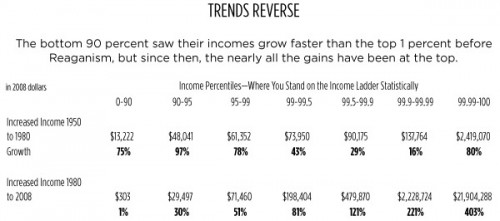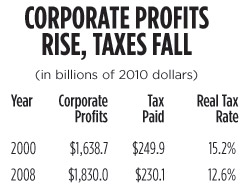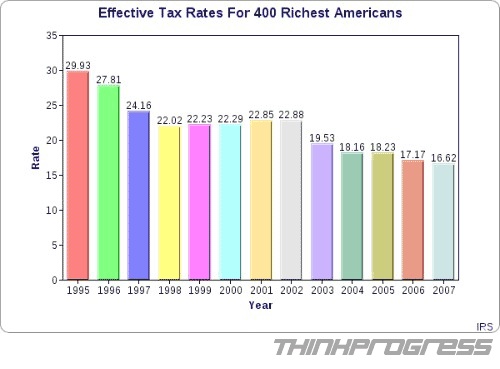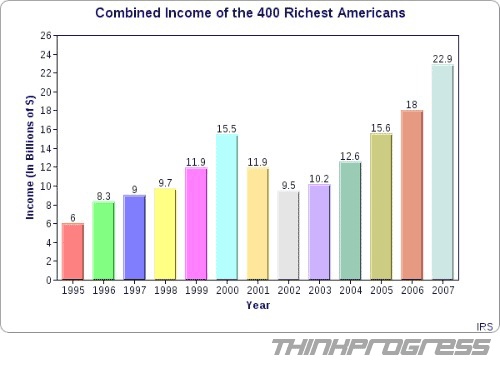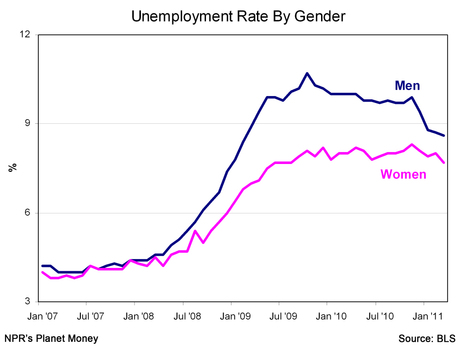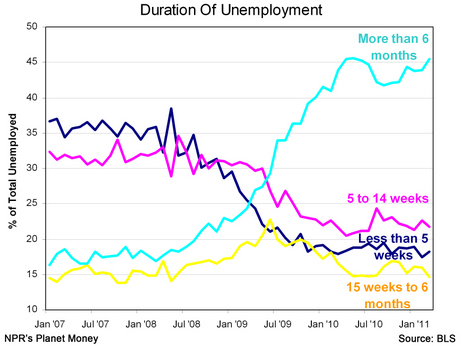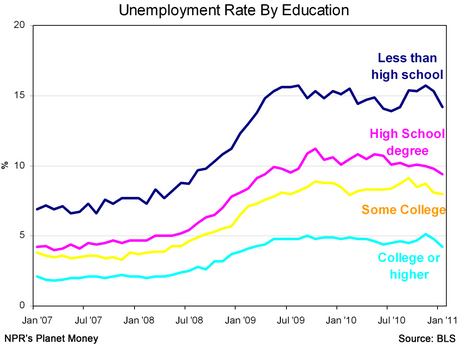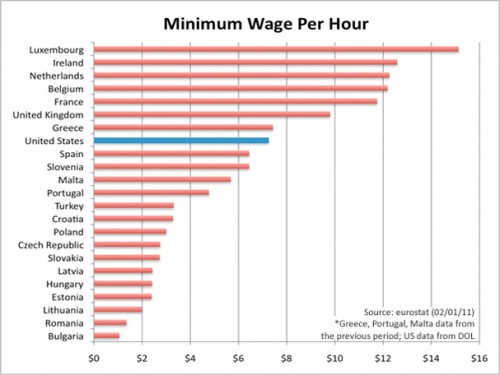Over the weekend I came across an interesting video of Mike Rowe, creator and host of Dirty Jobs. Rowe recently testified before the U.S. Senate’s Commerce, Science, and Transportation Committee. He made an impassioned case for the type of difficult but essential jobs he highlights on his show, as well as the vocational and other training programs that prepare workers for them — programs facing tremendous cuts due to state budget crises. While we hear a lot about the need to increase the level of 4-year college degree completion in the U.S., Rowe argues that skilled plumbers and welders are every bit as essential to our economic development, and that such jobs are worthy of respect and public support:
economics
People with a college degree are less likely to be unemployed than people without one (source: Andrew Sullivan):

But a college degree helps blacks less than it helps whites, especially in this recession (source: Andrew Sullivan):
See also Devah Pager’s stunning data on race, drug convictions, and employment prospects (in text or video). (Hint: it’s better to be a white felon than a black person with no felony record).
Via Thick Culture.
Lisa Wade, PhD is an Associate Professor at Tulane University. She is the author of American Hookup, a book about college sexual culture; a textbook about gender; and a forthcoming introductory text: Terrible Magnificent Sociology. You can follow her on Twitter and Instagram.
Claude Fischer, at Made in America, argues that the biggest change of the last 50 years is the increase in the number of mothers in the workforce. From the beginning of last century till now, that rate has accelerated precipitously:
While some women have always worked (at unpaid housework and childcare, selling goods made at home, or in paid jobs), most women now work outside of the home for pay. So long “traditional” family. Why the change? Fischer explains:
First, work changed to offer more jobs to women. Farming declined sharply; industrial jobs peaked and then declined. Brawn became less important; precise skills, learning, and personal service became more important. The new economy generated millions of white-collar and “pink-collar” jobs that seemed “suited” to women. That cannot be the full story, of course; women also took over many jobs that had once been men’s, such as teaching and secretarial work.
Second, mothers responded to those job opportunities. Some took jobs because the extra income could help families buy cars, homes, furnishings, and so on. Some took jobs because the family needed their income to make up for husbands’ stagnating wages (a noteworthy trend after the 1970s). And some took jobs because they sought personal fulfillment in the world of work.
And married working mothers changed the economy as well. Once it became commonplace for families to have two incomes, houses, cars, and other goods could be more expensive. Things women had done for free — everything from making soap and clothes, to growing and preparing food, and cleaning one’s own home — could be commodified. Commodification, the process of newly buying and selling something that had not previously been bought and sold, made for even more jobs, and more workers, and so the story continues…
Lisa Wade, PhD is an Associate Professor at Tulane University. She is the author of American Hookup, a book about college sexual culture; a textbook about gender; and a forthcoming introductory text: Terrible Magnificent Sociology. You can follow her on Twitter and Instagram.
What is the fiscal relationship between the Royal Family of the United Kingdom and its taxpayers? I have no idea.
Accordingly, I have no idea as to the accuracy of this 5-minute summary, made by CGP Grey (via), but it was entertaining and, I imagine, contains a least a kernel of truth:
U.K. readers, what say you? (Transcript after the jump.)
Captain Crab sent us an article by David Johnston in the Willamette Week that looks at changes in income inequality in the U.S. since 1950.Based on an analysis of research by Saez and Piketty (2007, with updated 2008 data available at Saez’s website–the first entry under “Income and Wealth Inequality”), Johnston calculated changes in income for various income percentiles in the U.S. Between 1950 and 1980, the bottom 90% of income earners saw their incomes increase by 75% (a gain of $13,222), a rate higher than or comparable to the highest income groups. However, between 1980 and 2008, incomes of the bottom 90% has largely stagnated, while the incomes of the super rich have soared (all data in constant 2008 dollars, adjusted for inflation):
As a result the difference between the median wage and the mean wage has widened (data from the Social Security Medicare Database):
Johnston also includes data on changes in corporate income tax rates, based on IRS data. The actual tax rate — how much corporations pay after various loopholes and tax breaks — fell between 2000 and 2008:
On a similar topic, Deeb K. sent in a link to images at Think Progress showing the actual tax rate of the 400 richest Americans between 1995 and 2007, based on IRS data. During that period, the effective tax rate of this group fell by 13 percentage points:
Their incomes, on the other hand, jumped significantly:
Also see my recent post on various illustrations of inequality in the U.S.
Sangyoub Park, who teaches sociology at Washburn University, sent us an interesting article posted by NPR on various aspects of unemployment. The overall official unemployment rate of 8.8 percent (as of March 2011) hides a lot of variation. For instance, the unemployment rate during this recession has been consistently worse for men than for women:
Nearly half of people have been out of work for at least 6 months:
The unemployment rate for those with a college education is under 5%, while for those who didn’t graduate high school, it’s nearly 10 percentage points higher:
Check out the NPR story for more discussion and a few more graphs.
The NPR article doesn’t include data on race, but Sangyoub found some racial data at the BLS website. As of March 2011, the unemployment rate for Whites was 7.9%, while for Blacks it was 15.5%.
The “poverty line” is an income, set by the federal government, used to measure whether one is in or out of poverty. But this line, of course, is both sociological and political. What is poverty?
A nonprofit organization called Wider Opportunities for Women has released a study challenging the federal poverty lines. According to the New York Times article on their work, their aim is to “…set thresholds for economic stability rather than mere survival, and takes into account saving for retirement and emergencies.” Their “lines,” then, deviate significantly from those of the federal government.
Lisa Wade, PhD is an Associate Professor at Tulane University. She is the author of American Hookup, a book about college sexual culture; a textbook about gender; and a forthcoming introductory text: Terrible Magnificent Sociology. You can follow her on Twitter and Instagram.
I am trying to re-enter society after several days being sick, so I’m going with something short and simple today. Eden H. sent in this chart, found at Business Insider, that compares hourly minimum wages in a number of European countries to the U.S.:
The European data are available from Eurostat (though note they report minimum wages in terms of Euros per month, not hour, so the data was converted for the chart).
People with a college degree are less likely to be unemployed than people without one (source: Andrew Sullivan):

But a college degree helps blacks less than it helps whites, especially in this recession (source: Andrew Sullivan):
See also Devah Pager’s stunning data on race, drug convictions, and employment prospects (in text or video). (Hint: it’s better to be a white felon than a black person with no felony record).
Lisa Wade, PhD is an Associate Professor at Tulane University. She is the author of American Hookup, a book about college sexual culture; a textbook about gender; and a forthcoming introductory text: Terrible Magnificent Sociology. You can follow her on Twitter and Instagram.
Claude Fischer, at Made in America, argues that the biggest change of the last 50 years is the increase in the number of mothers in the workforce. From the beginning of last century till now, that rate has accelerated precipitously:
While some women have always worked (at unpaid housework and childcare, selling goods made at home, or in paid jobs), most women now work outside of the home for pay. So long “traditional” family. Why the change? Fischer explains:
First, work changed to offer more jobs to women. Farming declined sharply; industrial jobs peaked and then declined. Brawn became less important; precise skills, learning, and personal service became more important. The new economy generated millions of white-collar and “pink-collar” jobs that seemed “suited” to women. That cannot be the full story, of course; women also took over many jobs that had once been men’s, such as teaching and secretarial work.
Second, mothers responded to those job opportunities. Some took jobs because the extra income could help families buy cars, homes, furnishings, and so on. Some took jobs because the family needed their income to make up for husbands’ stagnating wages (a noteworthy trend after the 1970s). And some took jobs because they sought personal fulfillment in the world of work.
And married working mothers changed the economy as well. Once it became commonplace for families to have two incomes, houses, cars, and other goods could be more expensive. Things women had done for free — everything from making soap and clothes, to growing and preparing food, and cleaning one’s own home — could be commodified. Commodification, the process of newly buying and selling something that had not previously been bought and sold, made for even more jobs, and more workers, and so the story continues…
Lisa Wade, PhD is an Associate Professor at Tulane University. She is the author of American Hookup, a book about college sexual culture; a textbook about gender; and a forthcoming introductory text: Terrible Magnificent Sociology. You can follow her on Twitter and Instagram.
What is the fiscal relationship between the Royal Family of the United Kingdom and its taxpayers? I have no idea.
Accordingly, I have no idea as to the accuracy of this 5-minute summary, made by CGP Grey (via), but it was entertaining and, I imagine, contains a least a kernel of truth:
U.K. readers, what say you? (Transcript after the jump.)
Captain Crab sent us an article by David Johnston in the Willamette Week that looks at changes in income inequality in the U.S. since 1950.Based on an analysis of research by Saez and Piketty (2007, with updated 2008 data available at Saez’s website–the first entry under “Income and Wealth Inequality”), Johnston calculated changes in income for various income percentiles in the U.S. Between 1950 and 1980, the bottom 90% of income earners saw their incomes increase by 75% (a gain of $13,222), a rate higher than or comparable to the highest income groups. However, between 1980 and 2008, incomes of the bottom 90% has largely stagnated, while the incomes of the super rich have soared (all data in constant 2008 dollars, adjusted for inflation):
As a result the difference between the median wage and the mean wage has widened (data from the Social Security Medicare Database):
Johnston also includes data on changes in corporate income tax rates, based on IRS data. The actual tax rate — how much corporations pay after various loopholes and tax breaks — fell between 2000 and 2008:
On a similar topic, Deeb K. sent in a link to images at Think Progress showing the actual tax rate of the 400 richest Americans between 1995 and 2007, based on IRS data. During that period, the effective tax rate of this group fell by 13 percentage points:
Their incomes, on the other hand, jumped significantly:
Also see my recent post on various illustrations of inequality in the U.S.
Sangyoub Park, who teaches sociology at Washburn University, sent us an interesting article posted by NPR on various aspects of unemployment. The overall official unemployment rate of 8.8 percent (as of March 2011) hides a lot of variation. For instance, the unemployment rate during this recession has been consistently worse for men than for women:
Nearly half of people have been out of work for at least 6 months:
The unemployment rate for those with a college education is under 5%, while for those who didn’t graduate high school, it’s nearly 10 percentage points higher:
Check out the NPR story for more discussion and a few more graphs.
The NPR article doesn’t include data on race, but Sangyoub found some racial data at the BLS website. As of March 2011, the unemployment rate for Whites was 7.9%, while for Blacks it was 15.5%.
The “poverty line” is an income, set by the federal government, used to measure whether one is in or out of poverty. But this line, of course, is both sociological and political. What is poverty?
A nonprofit organization called Wider Opportunities for Women has released a study challenging the federal poverty lines. According to the New York Times article on their work, their aim is to “…set thresholds for economic stability rather than mere survival, and takes into account saving for retirement and emergencies.” Their “lines,” then, deviate significantly from those of the federal government.
Lisa Wade, PhD is an Associate Professor at Tulane University. She is the author of American Hookup, a book about college sexual culture; a textbook about gender; and a forthcoming introductory text: Terrible Magnificent Sociology. You can follow her on Twitter and Instagram.
I am trying to re-enter society after several days being sick, so I’m going with something short and simple today. Eden H. sent in this chart, found at Business Insider, that compares hourly minimum wages in a number of European countries to the U.S.:
The European data are available from Eurostat (though note they report minimum wages in terms of Euros per month, not hour, so the data was converted for the chart).





